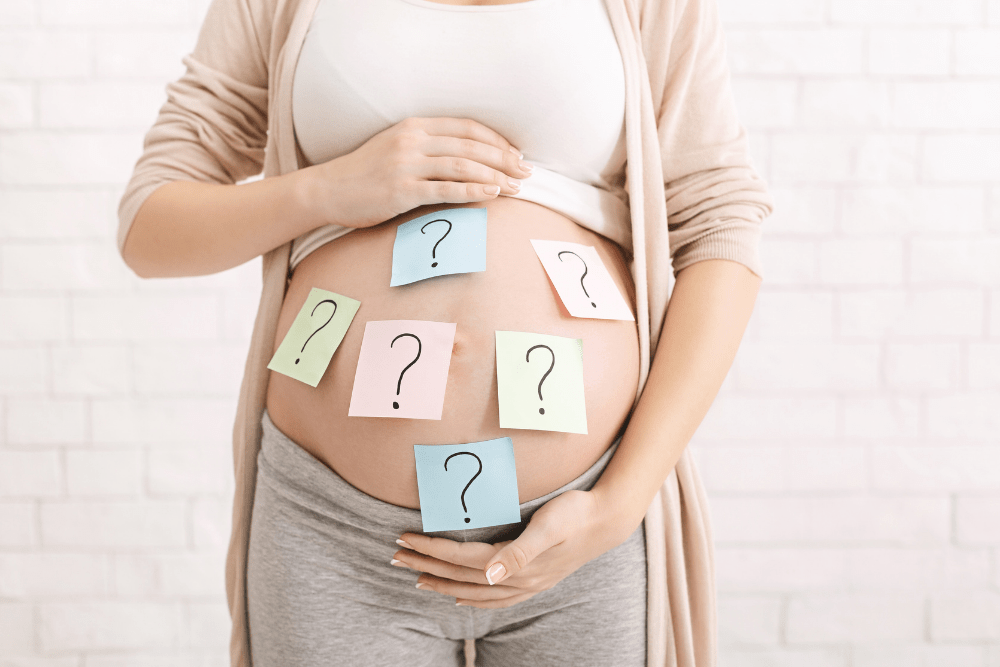
It’s a stormy night and a sleek Jaguar creeps along the road, avoiding the carnage with breathtaking precision. A beautiful young actress clad in a shimmering evening gown turns to her angular-jawed partner and gasps ‘It’s coming!’ Moments later, following two or three tumultuous contractions, several commercial breaks and plot deviations, she gives birth to a suspiciously calm and mature baby in an unbelievably clean and easy manner. And so begins our rather misleading education on labour and when it’s time to go to the hospital.
Later on, when we are actually pregnant and attending parent education classes, we get the ‘not too early, not too late, just right drill on when to come into the hospital. Then labour starts and it’s suddenly very unclear whether we should be ‘bold and beautiful’ or ‘perfectly balanced’ about the whole event.
Here are some helpful hints on how to recognise when it’s time to go to the hospital.
How does it all start?
The majority of labours begin between 38 and 42 weeks. Labour begins in a magical way as the interplay between the mother and baby. In the last weeks of pregnancy, the hormone oestrogen rises, overcoming the relaxing hormone progesterone. Two other hormones oxytocin and prostaglandin initiate contractions associated with true labour. The pressure of the baby’s head on the cervix and the enlarged uterus all contribute to the onset of labour. The baby also releases certain hormones to help start labour. In the few days or weeks before labour onsets, some women report habits such as ‘nesting.’ This involves cleaning and organising everything in sight in preparation for the imminent birth. Husbands get yelled at for dropping their socks in the wrong place and the pantry is cleaned and the products alphabetised! Women may also report feeling a bit spaced out and dreamy as hormones begin to surge. Vaginal discharge may also change and become heavier and more mucousy.
Pre-labour
Many women experience days, or even weeks of what is described as ‘pre-labour’ or otherwise poorly termed as ‘false labour’. This phenomenon is responsible for many a dash to the hospital and then a slow disappointing journey home.
Pre labour is when Braxton Hicks contractions, which have become a feature of your pregnancy in the last weeks, become stronger and more frequent. They may last a minute or more and whilst uncomfortable they generally don’t stop you from speaking or moving. They also tend to be irregular and start and stop.
The vaginal discharge becomes more prolific during this time. You may also have a show, which is a jelly-like, vaginal discharge with some blood in it. A show on its own does not mean, however, that you are in labour.
Whilst pre labour is not true labour, it is not wasted discomfort. All the activity in your uterus and cervix is getting your body and baby ready for birth. Try to get as much rest as possible during this period. Warm showers or baths can help ease the discomfort and may even get rid of the strong Braxton Hicks for a while. Don’t forget to eat and drink. If you can’t sleep get out some good videos or a good book. Make sure your bag is packed!
Put the answering machine on if the phone calls are driving you mad and try to be patient.
True Labour
True labour, otherwise termed, the first stage of labour, is when your Braxton Hicks start to become more regular and intense. Whilst they might have been lasting a minute or more before, they might now be lasting 30-40 seconds but be much more intense. Until those contractions are regular and increasing in length and frequency, causing the cervix to flatten out and open up, women are not actually in established labour. Once labour is established the cervix will open by 0.5 to 1cm per hour. If you come into the hospital before your labour has established you may be asked if you would like to go home again. This is not to be unkind; rather, home is often a much more comfortable and relaxing environment for you to be in than the hospital. Women also often labour better at home. Research has shown that women who come into the hospital before they are 3cm dilated end up with more interventions than women who come in after they are 3cm.
Sometimes contractions start 15 to 20 minutes apart and get progressively closer whilst for others they come 5 minutes apart and rapidly progress to 2-3 minutes apart. The key to recognising true labour is the contractions get stronger, longer and more frequent. Most important is they are regular rather than all over the place as they are with pre-labour. You will find it increasingly hard to talk or move about during a contraction. You may also begin to feel a bit ‘spaced out’ as the endorphins (natural drugs) flood your system.
If this is your first baby and you are between 38-42 weeks pregnant and everything has been straightforward in your pregnancy then you can afford to wait until the contractions are around 5 minutes apart or you feel you are not managing at home any more. If this is your second or third baby then wait until your contractions are around 7 minutes apart before contacting the hospital. Never be afraid to contact the midwives in the labour ward or birth centre earlier if you are worried.
When not wait
Don’t hesitate to ring the midwives:
- If you are having bleeding that is like a period, rather than just a ‘show’
- If you think your water has broken
- If your baby is preterm (under 37 weeks)
- If you have had a complicated pregnancy or previous complications like a caesarean section
- If you are having twins, triplets or more!
- If your baby is presenting as a breech (bottom first)
- If you are feeling pressure in your bowel with a contraction and want to push
- If you had a very rapid first labour (2-3 hours)
- If you have Group B Strep and need antibiotics in labour
- If you are really worried or not coping
Breaking the waters
You will know your waters have broken if your pants feel very wet or you have water trickling down your legs. Put a pad on at this point and check it in an hour. If it is blood stained or green then ring the hospital straight away. If it is quite wet or you continue to have little trickles of water then phone the midwives on the labour ward.
As vaginal discharge increases dramatically towards full term I commonly get phone calls from women who get up in the morning and feel something run down their legs. Vaginal discharge can pool in the vagina during the night and then trickle out when you stand upright. This discharge tends to be a bit sticky and milky and dries like egg white. This is quite normal. Fluid will generally continue to trickle out and wet your pad if your waters have broken.
If you think you have broken your waters then contact the midwives in the labour ward because they will probably want you to come in and check the baby is okay. They will also confirm the ruptured membranes if you are unsure and discuss your options further.
Labour may start straight away or not for several days after you have broken your waters. Some women will choose to wait a day or two for labour to start by itself while others will be anxious to be induced once the waters have broken.
Remember breaking your waters does not mean you are in labour
Common myths
- Your due date is very unlikely to be the date you give birth. Approximately 3-5% of babies are born on their due date.
- Having a show does not mean you are in labour it just means things will probably happen in the next week or two.
- Breaking your waters does not mean you are in labour or your baby will be born imminently
- The first contraction is not the time to rush in
- Rapid births in Jaguars in the middle of storms do happen… but rarely!
The decision about when to go into the hospital is not one you have to make on your own. Talk to the midwives in the labour ward or birth centre when you think you are in labour and they will give you more advice. Midwives can often tell just by listening to your voice whether you should come in or wait a bit longer. This will all help you get it ‘just right.’
Page revised on 10th December 2021


I once heard a useful piece of advice from a midwife on the topic of how to know when you need to go to hospital. Like most of the best advice it was simple; you will just know! For me, I can say that when I have to stop all conversation and close my eyes or chant during a contraction then things are getting closer and active labour has arrived.